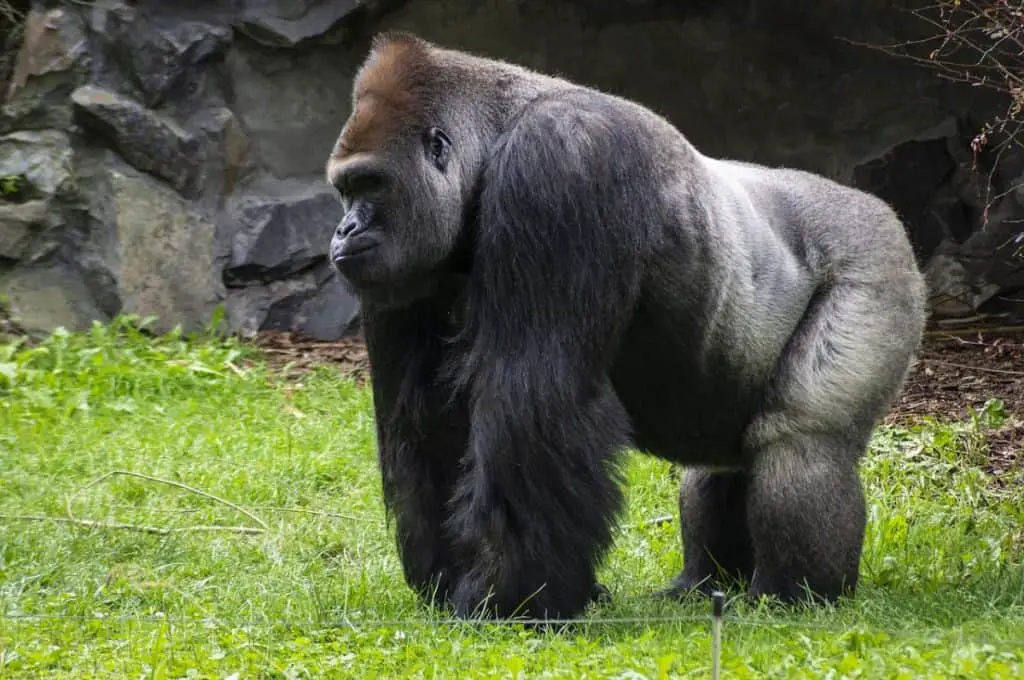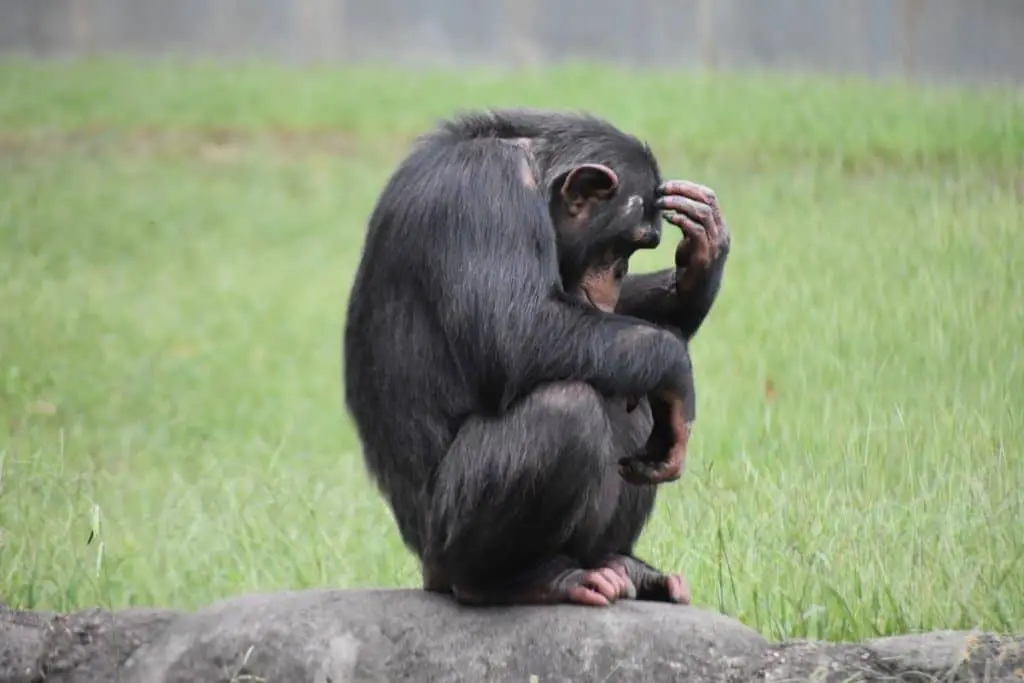Apes are man’s closest relatives, and together they make up the primate superfamily Hominoidea. There are about twenty-five species of apes alive in the world, divided into two groups.
Apes can be found in Asia and Africa and are distinct from their monkey cousins. Apes have no tails and can swing from branch to branch. Twenty gibbon species, three orangutans, two gorillas, the bonobo, humans, and the chimpanzee make up the Superfamily Hominoidea.
There is a clear difference between the smaller, medium-sized lesser apes of the family Hylobatidae and the much larger great apes of Pongidae.
The great apes and humans are closely related living primates. Fossil relatives of lesser and great apes have been discovered dating back to the early Miocene, some 20 million years ago. The lesser apes may have evolved as early as the Oligocene (about 35 million years ago), but the fossil record is incomplete.

Classification
The apes of the family Hylobatidae include all gibbons and the siamang and are classed into four genera. The first comprises three gibbons, organized under the Genus Hoolok. The Genus Hylobates consists of nine species of dwarf gibbons.
The Genus Symphalangus comprises the Siamang, a black gibbon found in Thailand, Malaysia, and Indonesia, while the fourth Genus Nomascus comprises seven crested gibbons.
Hominidae includes the great apes and is classed into four genera. Pongo includes orangutans, Gorilla consists of gorillas, Pan includes the bonobo and chimpanzees, and Homo relates to humans.
Superfamily Hominoidea
Family Hominidae: Hominids Great apes
Genus Pongo: Orangutans
Bornean orangutan, P. pygmaeus
Sumatran orangutan, P. abelii
Tapanuli orangutan, P. tapanuliensis
Genus Gorilla: Gorillas
Western gorilla, G. gorilla
Eastern gorilla, G. beringei
Genus Homo: humans
Human, H. sapiens
Genus Pan: chimpanzees
Chimpanzee, P. troglodytes
Bonobo, P. paniscus
Family Hylobatidae: gibbons Lesser apes
Genus Hylobates
Lar gibbon or white-handed gibbon, H. lar
Bornean white-bearded gibbon, H. albibarbis
Agile gibbon or black-handed gibbon, H. agilis
Western grey gibbon or Abbott’s grey gibbon, H. abbotti
Eastern grey gibbon or northern grey gibbon, H. funereus
Müller’s gibbon or southern grey gibbon, H. muelleri
Silvery gibbon, H. moloch
Pileated gibbon or capped gibbon, H. pileatus
Kloss’s gibbon or Mentawai gibbon or bilou, H. klossii
Genus Hoolock
Western hoolock gibbon, H. hoolock
Eastern hoolock gibbon, H. leuconedys
Skywalker hoolock gibbon, H. tianxing
Genus Symphalangus
Siamang, S. syndactylus
Genus Nomascus
Northern buffed-cheeked gibbon, N. annamensis
Black-crested gibbon, N. concolor
Eastern black crested gibbon, N. nasutus
Hainan black crested gibbon, N. hainanus
Southern white-cheeked gibbon N. siki
White-cheeked crested gibbon, N. leucogenys
Yellow-cheeked gibbon, N. gabriellae
Characteristics
Apes lack a tail, and their forelimbs are longer than their hindlimbs. The chest is barrel-shaped (rather than flattened from side to side as in monkeys), and the modified wrist structure allows for greater mobility.
Gibbons and siamang exhibit the most spectacular pattern of movement, known as true brachiation, in which the body swings beneath the branches, with the arms taking alternate holds. The great apes, on the other hand, move much slower through the trees.
The orangutan, the world’s largest living arboreal mammal, moves slowly and deliberately, suspending its body weight from all four limbs in a quadrumanous (four-handed) progression.
In contrast to their Asian relatives, African great apes generally move along the ground. Chimpanzees and gorillas both “knuckle-walk,” with the knuckles of the hands providing points of contact with the ground (orangutans, particularly old heavy males, may descend to the floor and “fist-walk” on the outer margins of the hands—a more rudimentary pattern of forelimb support).
Chimpanzees spend between a quarter and a third of their time in the trees, whereas gorillas spend only about ten percent.
There are many differences between gorillas and chimpanzees. You can find them here
Diet
The apes are all essentially vegetarian, though chimpanzees consume some animal food. Only the gorilla, the most terrestrial of the apes, is primarily a leaf eater rather than a fruit eater. The remaining apes’ suspensory feeding movements are linked to adaptations for feeding in terminal branches, mainly in gibbons and siamang.
Although animals account for a small portion of the chimp’s diet, its feeding behavior has piqued the interest of researchers due to its possible relevance to the emergence of hunting behavior in early humans.
Male chimps prey on other primates (e.g., red colobus and baboons) and medium-sized mammals (e.g., bush chimpanzees) at Gombe Stream in Tanzania; the chimps have a limited tendency to hunt cooperatively and share food. Chimpanzees, primarily females, also feed on termites with the help of a carefully selected twig.
Social Systems
The lesser apes are all monogamous, and the mated pair appears to stay together for life. Sexual maturity is reached at around six years of age in both sexes, and sexually mature adults leave their parents’ home range. As a result, the maximum size of gibbon and siamang groups is about five individuals. Adult males typically avoid one another, though adult females and immature orangutans may form small temporary groups.
Nonetheless, the orangutan likely has a social system based on overlapping ranges. Africa’s great apes have distinct social groups. The gorilla is essentially a harem animal, with groups consisting of a single mature silver-back male, a small number of younger males, several adult females, and babies. Lone silver-backed males are also typical.
There are at least two levels of grouping in chimpanzees. The basic social unit appears to be a community of 40 to 80 people, including numerous adults of both sexes. Still, it is unusual to find the community as a whole in one place.

Clear territorial behavior appears to be limited to chimpanzees and lesser apes. Gibbons and siamangs are well known for their loud territorial calls. Territorial demarcation seems more subtle in chimpanzees, though encounters between members of neighboring communities can result in death.
Lesser apes, like most monogamous mammals, have very little difference in body size between sexes, though some differences in coat coloration. Chimpanzees have a small size difference, but orangutans and gorillas have extreme sexual dimorphism in body size.
Regarding reproductive biology, apes, particularly great apes, are similar to humans. Maternal care of infants is extended in all apes, ranging from about 18 months in gibbons to nearly three years in great apes.

